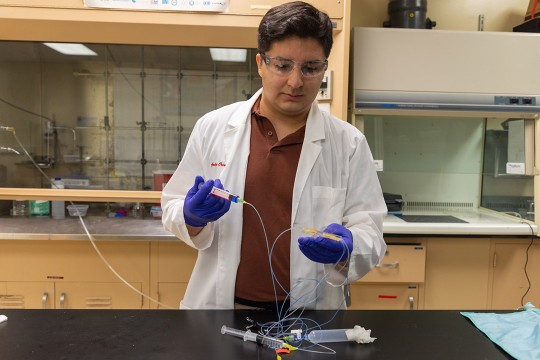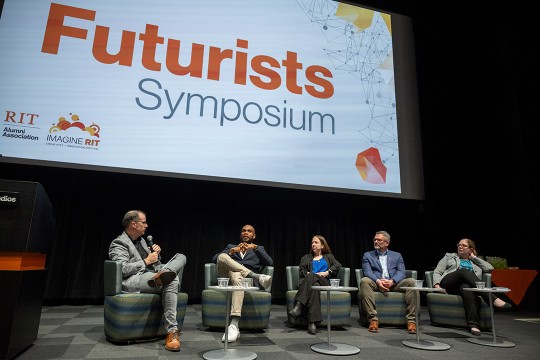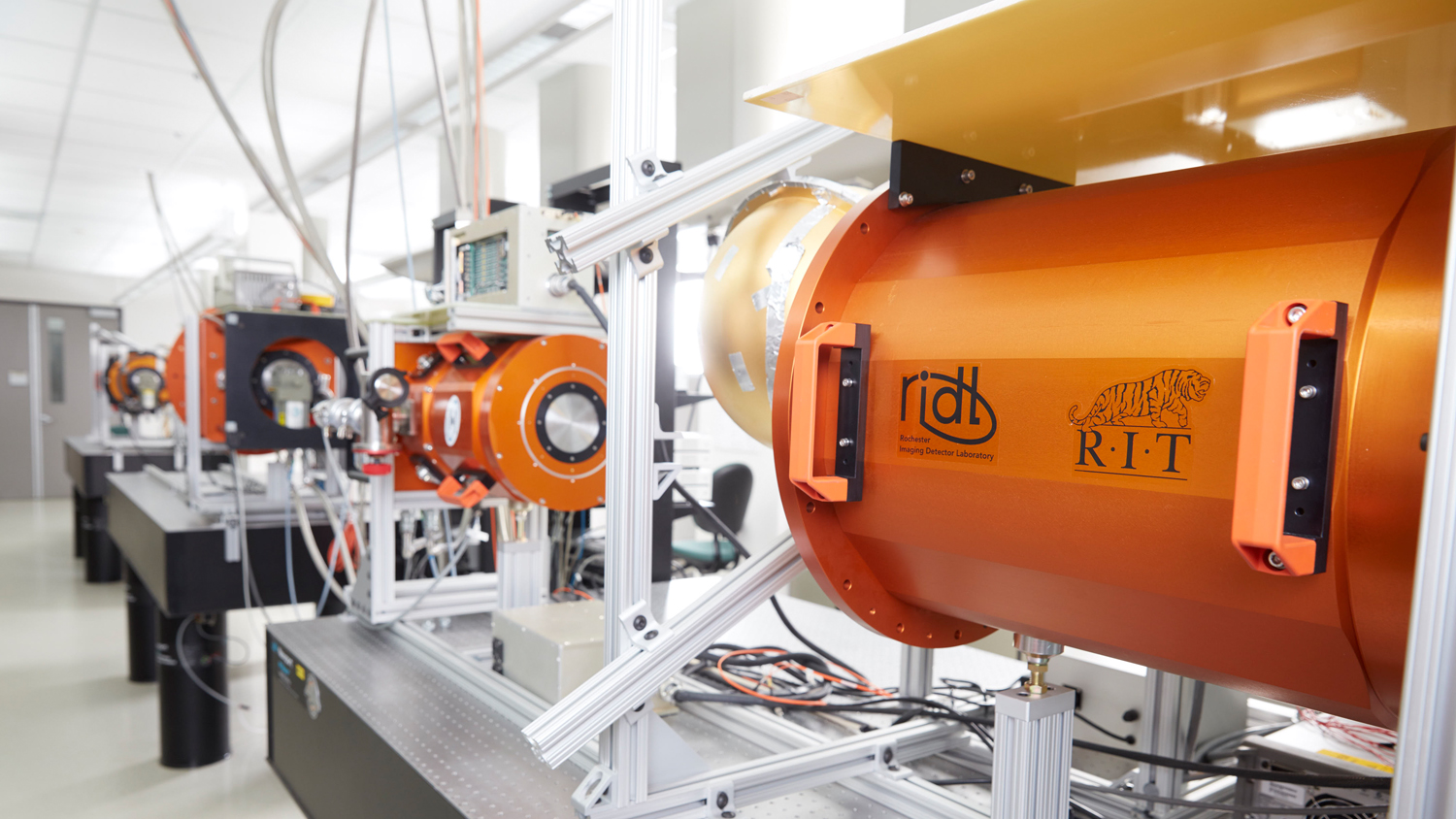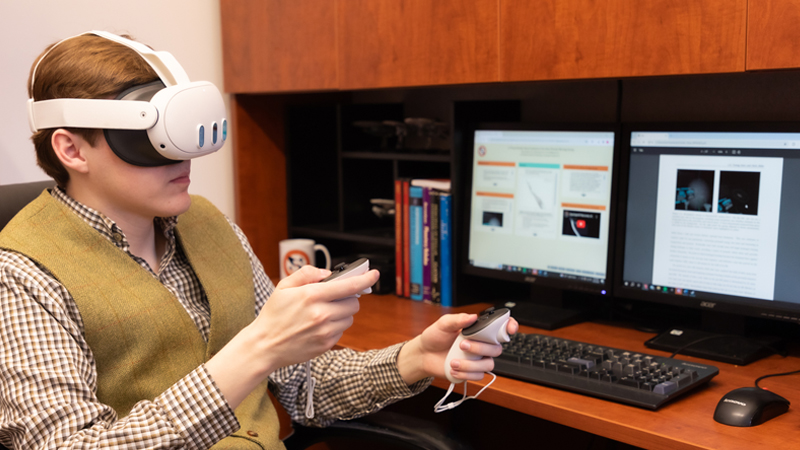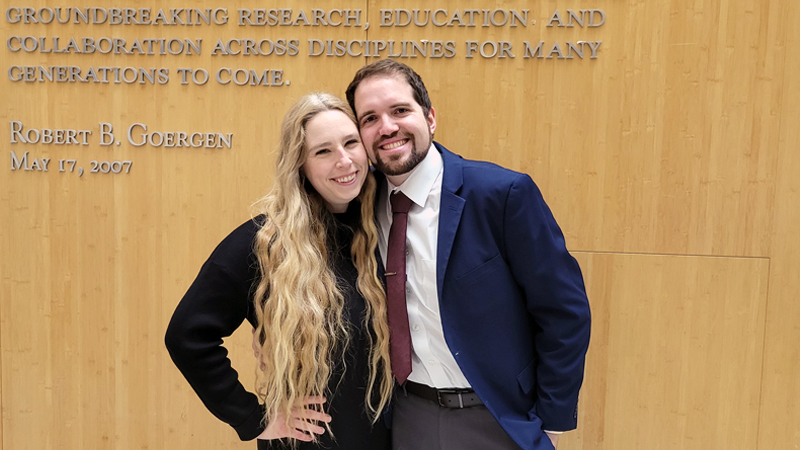School of Physics and Astronomy


School of
Physics and Astronomy
Breadcrumb
- RIT/
- College of Science/
- Academics/
- Schools and Centers/
- School of Physics and Astronomy
There has never been a more exciting time to study the exciting discipline of physics, spanning the workings of the sub-atomic world to the ever-expanding universe.
Overview
The BS Physics Program in the School of Physics and Astronomy offers a comprehensive curriculum that provides a solid foundation in experimental, computational, and theoretical physics, emphasizing laboratory training and the development of analytical problem-solving skills. Physics majors gain strong preparation for employment in research, industry, and teaching, and for graduate study in physics and related fields. BS Physics students also find graduate placements in various professional programs such as in medical, law, and business schools.
At the graduate level, the School of Physics and Astronomy offers PhD and MS programs in both Astrophysical Sciences & Technology as well as Physics. The Astrophysical Sciences & Technology PhD offers extensive curricula and research opportunities spanning topics in stellar, galactic, and extragalactic astrophysics, as well as the fields of general relativity, gravitational wave astronomy, and instrument/detector development. The Physics PhD provides opportunities for in-depth research and study in areas such as atomic physics, biophysics, condensed matter and applied physics, as well as physics education research. Additionally, the School offers a general Physics MS Program that spans the various sub-disciplines in the field of physics, and provides both a research and a professional option to students.
50%
Of astrophysical sciences and technology doctoral students are women
11
Average number of undergraduate co-authors on peer-reviewed publications annually (2013-2018)
4
BS/MS accelerated 5-year dual degree programs offered
Undergraduate Programs
The undergraduate program in physics offers a broad curriculum preparing students for employment in research, industry, and teaching as well as excellent preparation for graduate school. The individualized research capstone component of the program provides our students with a competitive edge when seeking entry into preferred graduate programs and the job market.
In RIT’s physics degree, you’ll gain an in-depth understanding of the basic principles governing the structure and behavior of matter, the generation and transfer of energy, and the interactions of matter and energy within the world around us.
Learn more about the Physics BS programGraduate Programs
Our graduate programs offer advanced training in physics and astronomy and provide opportunities spanning a wide variety of research and professional areas. Students in the MS Physics program can choose between either a research (i.e., thesis) option or a “professional” option. Students in the Astrophysical Sciences & Technology programs engage with RIT’s world-class research centers offering cutting-edge opportunities in gravitational waves, new advanced sensor technologies, and multi-wavelength astrophysics.
A master’s in astrophysics that explores the depths of the universe through multidisciplinary research, from general relativity to theoretical astrophysics, observational or instrumentation development, and other areas related to astrophysics.
Learn more about the Astrophysical Sciences and Technology MS programAn astrophysics Ph.D. centered on phenomena beyond the Earth and on the development of the technologies that will enable the next major strides in the field.
Learn more about the Astrophysical Sciences and Technology Ph.D. programA physics MS that solidifies your understanding in core areas of physics with the flexibility to pursue your area of interest.
Learn more about the Physics MS programRIT’s physics Ph.D. combines our interdisciplinary approach, renowned faculty, and cutting-edge facilities to empower you to excel in your research and shape the future of physics.
Learn more about the Physics Ph.D. programMinors and Immersions
The astronomy immersion provides students with the opportunity for additional study in astronomy in order to build a secondary area of expertise in support of their major or other areas of interest. The immersion offers a broad background in astronomy with courses providing a broad survey of modern astrophysics and the techniques and technologies used to investigate astronomical phenomena.
Learn more about the Astronomy Immersion programThis minor provides students with an opportunity for additional study in astronomy in order to build a secondary area of expertise in support of their major or other areas of interest. It will provide students with a broad foundational background in astronomy in preparation for graduate studies in astronomy or astrophysics. The minor is interdisciplinary and offered jointly by the School of Physics and Astronomy and the Chester F. Carlson Center for Imaging Science.
Learn more about the Astronomy Minor programIn a broad sense, the aim of physics is to develop interconnected unifying threads bridging the vast number of seemingly diverse phenomena observed in the physical world around us. This immersion provides students with the opportunity for additional study in physics in order to build a secondary area of expertise in support of their major or other areas of interest.
Learn more about the Physics Immersion programIn a broad sense, the aim of physics as a discipline is to develop interconnected unifying threads bridging the vast number of seemingly diverse phenomena observed in the physical world around us. The minor provided students with the opportunity for additional study in physics in order to build a secondary area of expertise in support of their major or other areas of interest.
Learn more about the Physics Minor programThe minor in quantum information science and technology provides an introduction to the foundational concepts of quantum information science. Topics focus on how quantum devices are designed and operate and how they are being applied in emerging technologies, such as quantum computing, cryptography, and sensing.
Learn more about the Quantum Information Science and Technology Minor programLatest News
-
April 29, 2024
![a student is standing at a lab table testing micron glass beads to improve visualization under fluorescent microscopes.]()
Students discover research opportunities on the path to graduation
Independent research projects can help cultivate critical thinking, collaboration, and problem-solving skills. Whether it’s late nights spent in a RIT lab or a field study in the mountains, research experiences can be a cutting-edge way for students to prepare for the future.
-
April 27, 2024
![5 people are shown on a stage, sitting in gray chairs. The speaker on the far left is holding a microphone speaking to the others. A poster that says Futurists Symposium is shown behind them.]()
University’s ‘futurists’ encourage audience to embrace curiosity during Imagine RIT symposium
Be curious because what if, said RIT alumnus Bob Morrealle, who shared stories of discovery, hope, and confidence during his presentation at the Futurists Symposium, a collection of alumni and faculty offering an insider’s look into the future of technology, the arts, and design. The symposium, held April 26 in the Wegmans Theater, MAGIC Spell Studios, was the official kickoff to Imagine RIT: Creativity and Innovation Festival.
-
April 15, 2024
![Aiden Miller is shown posing in front of their research which is hanging on a building window.]()
Biochemistry student receives Barry M. Goldwater Scholarship
RIT third-year biochemistry student Aidan Miller has been awarded a Barry Goldwater Scholarship, the most prestigious undergraduate research scholarship in the United States, given to students pursuing a career in the natural sciences, mathematics, or engineering.
Research
RIT faculty participating in the Center for Detectors are involved in the design and development of the next generation of instruments and technologies for astrophysics. We participate in a variety of ground-based, sub-orbital, and orbital programs designed to probe from our solar system and galactic neighborhood out to the most distant regions of our universe.
Research Active Faculty:
Physics research in condensed matter and materials encompasses theory and experiment. Theorists utilize electronic structure calculations, molecular dynamics simulations, and kinetic Monte Carlo modeling to study and design oxides, metals, and alloys at various length and time scales. Experimentalists are focused on the study of metals, oxides, surfaces, and magnetic systems through x-ray scattering techniques such as coherent scattering and surface diffraction, as well as imaging techniques such as atomic force microscopy.
Research Active Faculty:
Current research areas overlapping the disciplines of Physics and Engineering include such topics as optoelectronic and photovoltaic devices, surface and materials characterization, instrumentation for fundamental physics, complex fluids, and micro-fluidics. Research programs in the School of Physics and Astronomy, for example, aim to increase photovoltaic power conversion efficiency and/or reduce materials costs and consumption through the use of nanoscale and novel materials. Activities encompass materials synthesis by vapor phase epitaxy, device fabrication, material and device modeling, as well as characterization both at the electrical and materials level, and computational design of nano-materials for energy technologies, and complex fluids-structure interaction at the micro-scale for oil recovery.
Research Active Faculty:
RIT faculty participating in the Center for Computational Relativity and Gravitation and the Laboratory for Multi-wavelength Astrophysics conduct observational and theoretical research across a wide range of topics in multi-messenger and multi-wavelength astrophysics, utilizing a combination of observations spanning the electromagnetic spectrum, data from gravitational wave detectors, and supercomputer simulations. Current areas of research include numerical relativity and relativistic magnetohydrodynamics, gravitational wave data analysis, compact object binaries, accretion disks and jets, galaxy formation and evolution, large scale structure, active galactic nuclei, observational and experimental cosmology, early and late stages of stellar evolution, protoplanetary disks, planetary nebulae, the interstellar medium, supernovae, and pulsars. RIT is a member of the Large Synoptic Survey Telescope Corporation and faculty are involved in several major collaborations including the Laser Interferometer Gravitational Wave Observatory Scientific Collaboration, the NANOGrav Pulsar Timing Array Consortium, the Laser Interferometer Space Antenna, and the Cosmic Evolution Survey.
Research Active Faculty:
The Physics Education Research group combines physics disciplinary knowledge with cognitive science, psychology, instructional design and social science to study fundamental and applied topics in physics education. Core areas of study at RIT include: career preparation of physics majors, communication skills for scientists, identity, diversity and inclusion in physics, student epistemic framing while problem solving, educational technology development, and graduate school admissions and retention. Physics faculty are part of a larger discipline-based education research community at RIT which includes researchers in biology, chemistry, engineering, and computing. The group is distinguished by its collaborative structure that is consciously designed to maximize interactions across the disciplines.
Research Active Faculty:
Current optics research in RIT Physics consists of a combination of theory and experiments. Theorists are focused on characterizing silicon nano-photonic networks and exploring quantum sensing and mesoscopic quantum physics. Experimentalists are currently investigating problems in integrated photonics and imaging, including the quantification of entanglement for the purposes of computing, simulation, and secure communication.
Research Active Faculty:
Physics faculty engaged in research on the atomic and nanoscale structure and dynamics, at a variety of length and time scales, utilize and further develop x-ray, neutron, and laser light techniques and instrumentation. In addition to x-ray scattering/spectroscopy from surfaces and laser scattering from particulate or structured solutions performed at RIT, x-ray experiments are performed at national synchrotron facilities and neutron experiments take place using instruments at national spallation and reactor sources. RIT physics faculty are also developing a new spin-polarized neutron scattering technique and instrument in which the spin polarizations of sample target nuclei are selectively manipulated using nuclear magnetic resonance techniques.
Research Active Faculty:
Biological physics researchers at RIT are studying molecular interactions related to cataract disease and to the eye vitreous, using scattering techniques, nuclear magnetic resonance, confocal microrheology, and statistical thermodynamics modeling. Theorists are studying the roles of connectivity, structural and functional heterogeneities, and proximity to phase transitions in determining the robustness and adaptability of biological networks in cells and tissues, as well as networks of neurons. Such work can lead to design principles for bio-inspired, engineered systems. Soft matter researchers focus on understanding the physics of systems of many interacting bodies. Areas of research include using micro-fluidics and fluorescent optical imaging to study the complex fluids confined in solid phases where interactions are mediated by hydrodynamics, and using light and other scattering methods to study micellar and micro-emulsion systems. RIT physicists also study granular materials, collections of larger particles (sand, sugar, and coins) that interact primarily through contact forces.
Research Active Faculty:
Research Affiliates
Manasse Mbonye (RIT-Rwanda)
Eleanor Sayre (RIT-CASTLE)
Visiting Scholars
Fred Moolekamp
Featured Work
Exploring the Potential of Virtual Reality for Analyzing Astronomical Data
Ryan Butler (astrophysical science and technology)
Ryan Butler, a Ph.D. candidate in the Astrophysical Science and Technology program at RIT, is exploring the use of virtual reality to analyze astronomical data.
RIT scientist helps explore mysterious shadow play around planet-forming disk
Professor Joel Kastner is part of a new Hubble Space Telescope study examining TW Hydrae.
Astrophysics Ph.D. Research: How Galaxies Form and Evolve
Brittany Vanderhoof (astrophysical sciences and technology)
Ph.D. student Brittany Vanderhoof chose RIT for the diverse range of research and accessibility of professors. Now she’s growing as an astrophysicist and researching how galaxies form and evolve.
Featured Profiles
From RIT and Cornell to Co-founder of Kanvas Biosciences
Hao Shi ’13 (BS Physics)
After studying physics at RIT and Cornell, Hao Shi ’13 now uses his quantitative skills as co-founder and CTO of Kanvas Biosciences, a company dedicated to developing innovative live biotherapeutics.
Explore Undergraduate Research, Discover a Passion, Land a Career
Tyler Godat ’16 (physics and applied math)
Tyler Godat ’16 chose RIT because of its reputation for undergraduate research, co-ops, and internships. Now, he is an optical measurements engineer at Corning.
Squishing the Barriers of Physics
Four RIT faculty members are opening up soft matter physics, sometimes known as “squishy physics,” to a new generation of diverse scholars.
Would you like to donate to our school?
Your gift helps the university support students, attract great faculty members, and maintain leading-edge academic programs.





